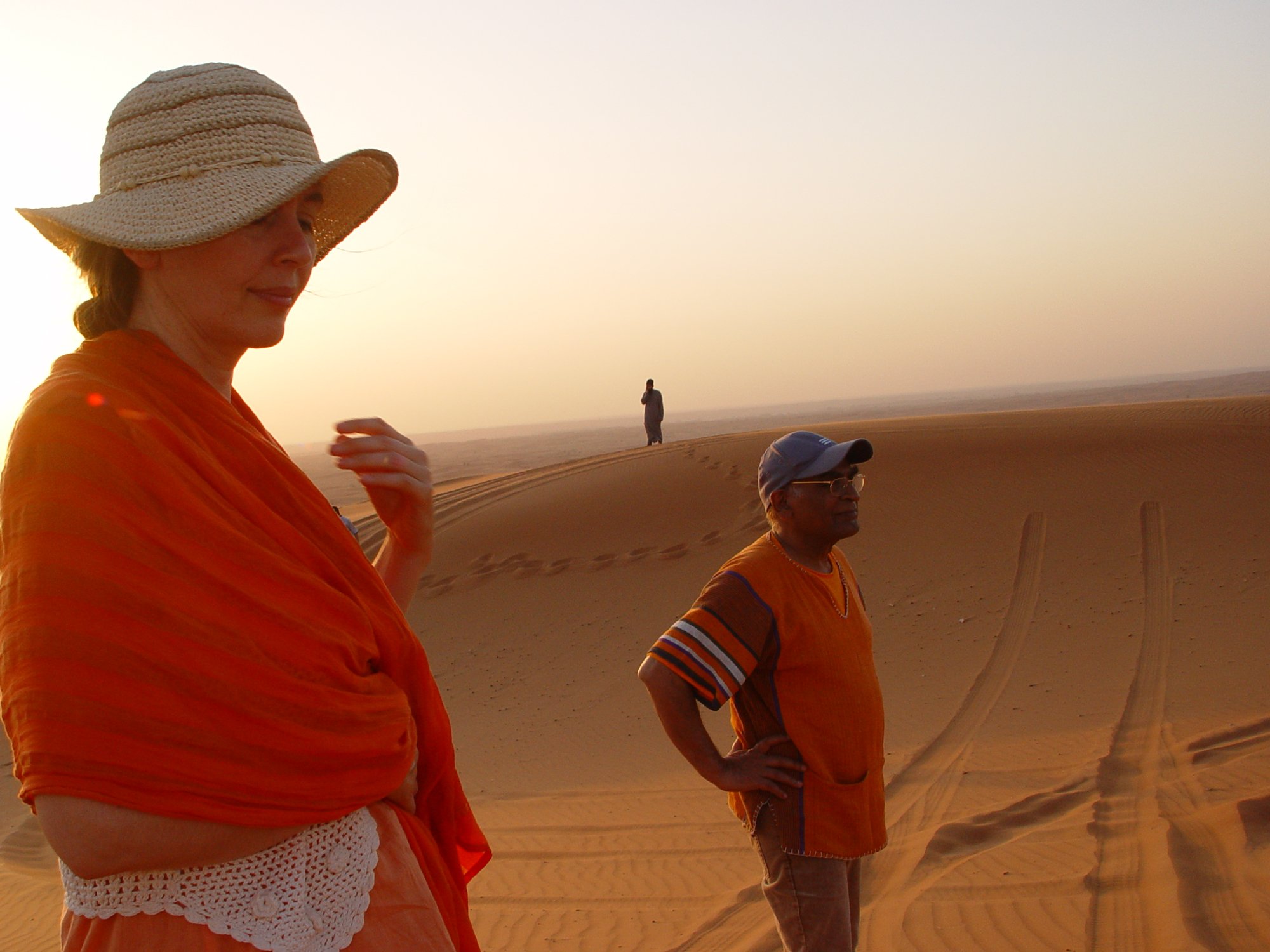You must let yourself be swallowed up …

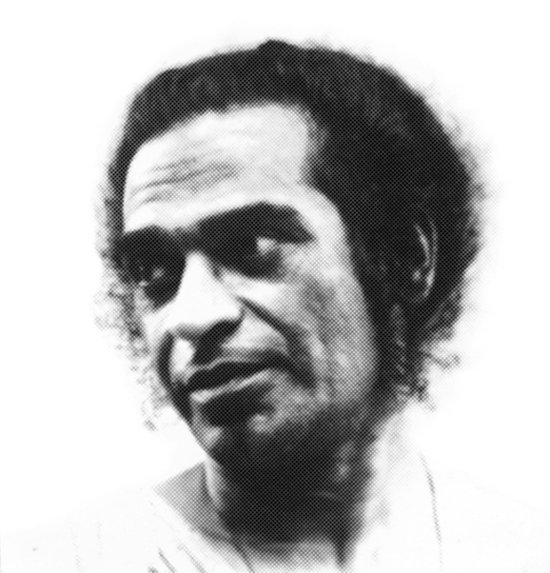
Interview with Sohan Qadri
“The secret of the form is in the formless” (Rig Veda)
We must see through the form, break the laws of the form the way we perceive it and sense the secret of the form, beyond the form.
“Break the form and reach the essential” (Rig Veda)
You are used to seeing the form with your eyes. If you do not break the form, you experience it as you are used to, with your eyes. But if you will find your way to the meaning of the form and perceive its essence, you must ‘break’ the form and you will reach ‘rupa’ beauty, the innermost form that it hides.
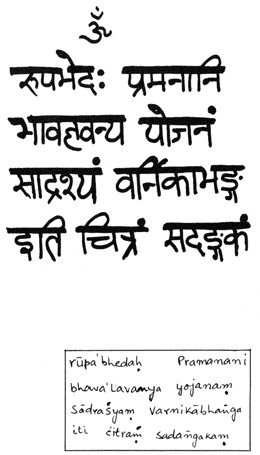
When you draw a yantra, you experience the form in the formless. In the beginning, there was no symbol.
Bindu: First you destroy everything, and then you let the form emerge?
I am a dot
born out of THE DOT
passing by the dots
dying into THE DOT
Sohan: Exactly.
The Symbol
Bindu: How did your interest in tantric art begin, your work with symbols?
Sohan: The symbol is something you reach when you have let go of all symbols, all visual memory. You must forget all that you know beforehand.
Every creative action involves the very same as creating a tantric symbol. Some people are not aware, so they do not realize the effect, or they cannot evoke the powers. Or if the powers are evoked, they cannot use them.
I am a dot
— dark
in the dark space
unidentified
The forces are called forth all the time, but the calling also reflects upon yourself. From a certain painting, I have had the experience that this calling forth or awakening it also reflects on me. This is what is tantric. I don’t just do something, it also reacts on me. When I am aware of this reaction on myself, then it is a symbol. This is essential for the tantric tradition.
Bindu: But you must see how one can be preoccupied with aesthetic norms, they are not part of this?
I am a dot
in the space
among the stars
Sohan: The aesthetics have been limited by the materialistic — poetry, literature, painting and the description of them is so limited that it must be nice and it must please. As long as it is only through the senses and conceptions you perceive, so long, you do not perceive the magic in a picture.
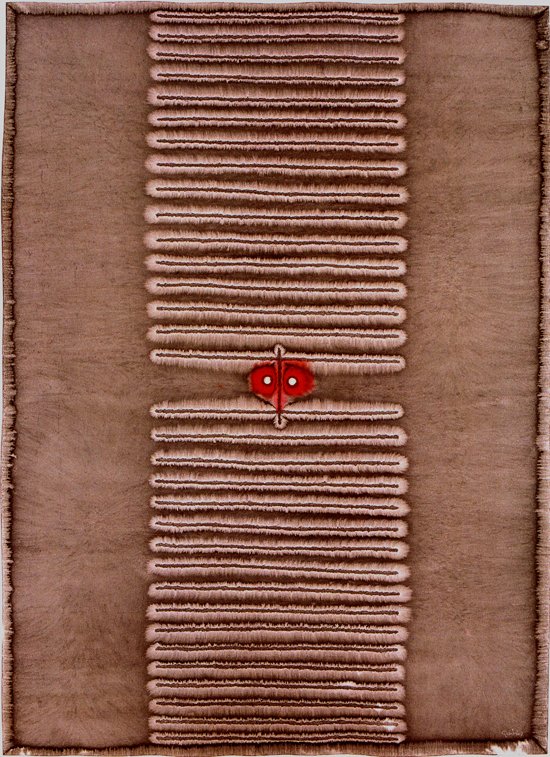
I am not against sense perceptions, it is enriching and satisfying, but it stays on the material level. It will not be explored further. In primitive art however, it is very much part of it. There is more closeness — you touch other levels than just the senses. Tantra art is not just for the senses. The symbol awakens something that is beyond the senses, beyond the aesthetic.
I am a dot
riding a ripple
on the vast waters
The modern painter is tired of the golden Greek pictures, because they have become limited to the senses. He wanted to reach something else. Today, many find other values beyond those for the senses, something strong, something that liberates. They bring you further, when you are open to the insight.
What is Tantra?
Bindu: Sohan, what is your definition of Tantra? Is it a way of living, is it a system or philosophy, or is it something practical or what is it?
I am a dot
in the seed of the sea;
the seed of the seeds
Sohan: It is a discovery that there is something beyond the aesthetic, beyond what we are used to experiencing with our senses. As a painter for instance, I can see how some have discovered something that is against the ‘laws’ of painting, those ‘laws’ that the Greek aesthetics have defined and carried on in a tradition. Just like there is a religious aesthetics.
Bindu: Would you say that Tantra is against the religious?
Sohan : Tantra is a rediscovery of the primordial, which today is possible to apprehend.
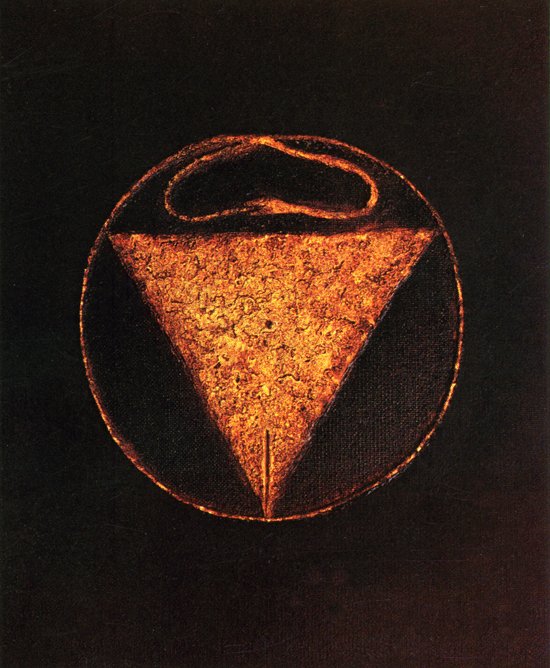
Earlier, in primitive times, Tantra has been a highly developed philosophy and practice, and as such, even today, it is practised in India. There has, however, been an aesthetic development, that is a puritan development, a development that limits the experience to the senses. Religion all over the world became for the senses, just like art became something for the senses. It became something purely materialistic, even philosophy became something for the senses. That happened in order to become acceptable for the people, so that there would be more and more followers. In order to get power.
I am a dot
in the midnight sun
in the arctic mysteries
Bindu: You mean, instead, the confrontation, the original direct experience?
Sohan : Yes, power, religious power, getting more and more, make people a little dull in the head and make them become more and more closed. Aesthetics means that we set limits, we make a law and laws are always against liberation. Tantra is liberation.
I am a dot
following or followed by
the northern-lights
We have an aesthetic law, we have it in religion, and we have a social one; the social aesthetic, the social norm or taste, means for instance that we don’t walk around naked, in order not to disturb the senses of others. The senses have been accustomed to regard things in a certain way.
Aesthetics is against liberation. And Tantra is liberation.
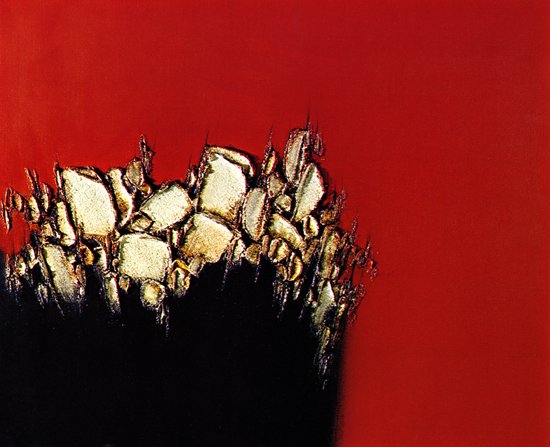
It is easy to give an impressive lecture about a philosophy for the senses. Why it will be convincing? Because we are already convinced. We are conditioned. While it may be inconvenient to go through Tantra. We want the aesthetics, we want in some way or another to cover up something, to keep something at a distance. Confrontation is to become naked, to remove that veil that the aesthetics covers things with.
Childhood
I am a dot
in the heart of ice-crystal
times old
in the antarctic mysteries
Bindu: How old are you Sohan?
Sohan: In fact, I don’t know how old I am. I don’t know my birthday. My mother knows what was grown in the fields when I was born. It was the cotton season, she says. When the cotton was flowering.
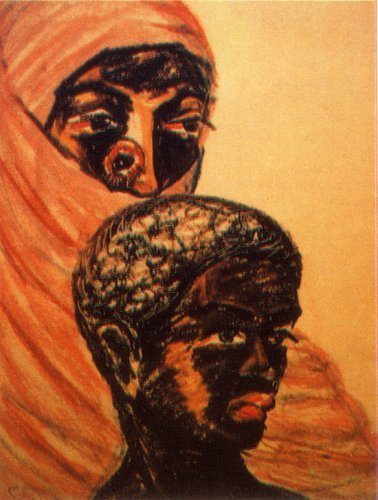
In many villages in India there is no register. It is the astrologer, the wise man, the herbal doctor, who is the one keeping records. He is supported by the village, but he leads a normal family life, he is not a sadhu. He has a wife and children and a home, like other people. But his food and expenses is provided by the village.
I am a dot
in the dew-drop
on the tip of the
morning grass-blade
In my village, there was a man who was also taking care of two to three other villages. He got a little of the harvest from the fields. Every one gave a little and that he lived from. His work was then to take care of all these things, occult things, astrology, rituals, he was a herbal doctor and a magician and he was seen as a wise man. He was the one who knew what was going on.
He has a chart, when a child is born, he then makes a horoscope. And when the village or a person wanted to know something about life, they would go to him.
Every year, the astrologer used to go to the Himalayas for 2 to 3 months to meditate. And one year, he did not come back. He used to take some of the horoscopes along with him to study them, perhaps together with his guru.
I am a dot
in the seed
in the womb of the mother
I discovered this when I was to be enrolled at the university. I asked my mother about my birthday and she said: ‘The village astrologer will know’. His son looked for it but my horoscope was not found.
Bindu: What kind of school did you attend?
Sohan: I went to the village school where you bring a small mat to sit on.
I am a dot
between the four lips
of the lovers
Bindu: Outside?
Sohan: Yes, under a big tree.
Bindu: This, of course, is exotic for a Northern European, but what you learn, that is the same I suppose. Did you learn English?
Sohan: No, only from the sixth grade, and then we had to learn it. We were still a colony, you know.
Bindu: We also started with English around the same time in Denmark.
Sohan: In fact, I did not have anything in the beginning, nothing to write with, I began with the finger. We had a pouch of cloth with ash in it that was spread on the ground, and when we finished writing, then we collected the ash and took it home with us.
Bindu: Was it Sanskrit or Hindi, or …
I am a dot
on the tip
of the creator's pen
Sohan : It was Punjabi, that is my mother tongue. But the man that taught us in the village was not an educated teacher. His craft was weaving, but he knew a little more about letters than the others in the village, so he was the teacher.
The ritual
Bindu: Can you tell us something about your work as a painter
I am a dot
in the sigh of the frustrated
in the sob of the forlorn
in the cry of the desperate
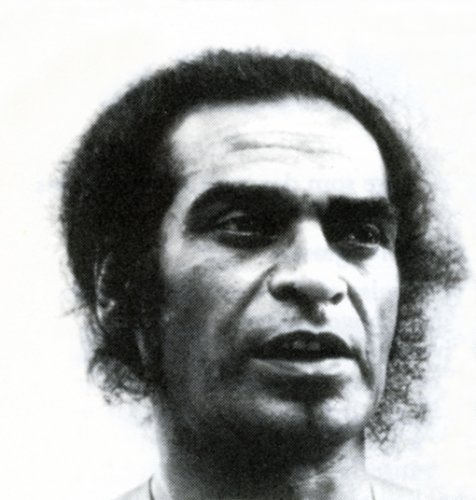
Sohan: Any painter in Denmark has a ritual when he paints a picture, but he may not be aware of it. For me, to paint a picture is more of a ritual, it reaches somewhat further than mere painting. It is a way to call forth the powers that are hidden in the emptiness of the canvas. The ritual will only give you power if you infuse the object with power.
I am a dot
in the thought,
the speech
and the action
A ritual is not just to take power. The definition of a ritual is that you must empty yourself first, then you get something in return. You must know how the ritual works, for if you cannot empty yourself, you get nothing.
The ritual gives you power and discipline and stability. Otherwise, the power becomes a burden for you, so discipline is needed very much.
I am a dot
in the silence
of the wise
I believe that any act that man is doing with awareness — is yoga. To make a chapatti is just as much yoga for me as painting a picture is — to cook or to consider something.
For the painter, there is an empty canvas, and that is a flag — hungry with an open mouth, and if you don’t feed this canvas with something, then you will never get a picture painted. You are the food, the artist is the food. He must let himself be completely swallowed. That is how a ritual works.
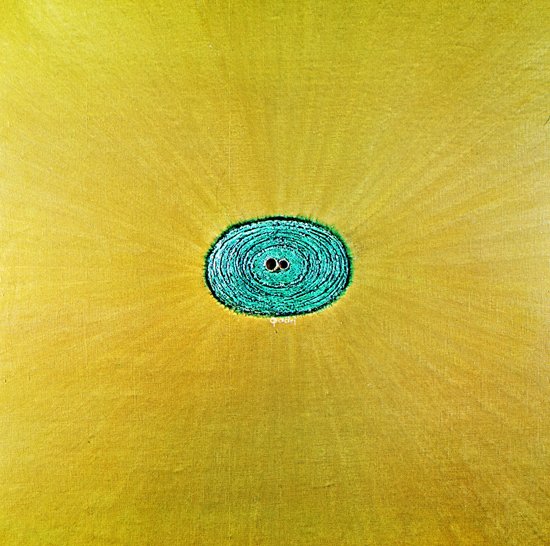
I am a dot
in the spark of life
from the flame
that burns to clean
If you do not do it this way and devote yourself completely to the ritual, then you do not get anything in return — and the picture will not be painted.
Let’s say you have a lingam or another figure, or that you visualize something, or you want to pray — say I want to pray to this inner picture, then it is this picture that is like an open mouth.
I am a dot
in the exhalation
and inhalation
of the yogi
This is a powerful confrontation, and you must let yourself be swallowed, skin and all; there are no halfway solutions — then you will get it back.
This is not like a cunning or an intellectual action, it is a question about being aware and awake. The canvas is lying there in the studio like a material confrontation and I am standing there. And even if I am not in the studio, the canvas is there anyway and I am there anyway. It is a mutual confrontation.
I am a dot
in the mindfulness
and the mindlessness
When it is limited to a certain area, a certain dimension, a certain piece of work and a certain size of the canvas, then it is a creative limitation.
When you scratch your knee, then it is the knee that feels it, not the shoulder. You choose your field of action. This choice is the limitation. The canvas has a boundary. It happens all the time.
It’s all a big ritual. We can cut out a little part and fill it up, fill it and become filled yourself. If you do not become filled, then you get nowhere.
Bindu: This is why you cannot learn anything if you are full of ideas and expectations beforehand. You must be able to receive a guidance without judging or interpreting. You must dare just to experience.
I am a dot
in the dance
of the ova and sperma
Swami Janakananda: I once had a teacher in Denmark, he is Italian and a painter, Giorgio Musoni, we drummed together, he taught me to drum. We also drummed together with African drummers and dancers who came with a show from Senegal. We learned a lot from that. Then he went to Africa for a period while I was in India.
One day being home again, we were together one evening and played. And I had not touched a drum during my years in India. He was surprised and said: “I must say, I have been in Africa and changed my way of drumming with many new rhythms, and then you come and play the same rhythms. How is that possible?”
“I don’t know” I said. “I just play together with you.”
I am a dot
in the pain of loneliness
and the conflict of
togetherness
“Now I see”, he said. “What one of the old drummers said to me — I see how he was right. He told me that the old drummers play only now and then, otherwise they never touch a drum, they let the young people drum.
And then this master told me: “You don’t always need to drum to become better at it.”
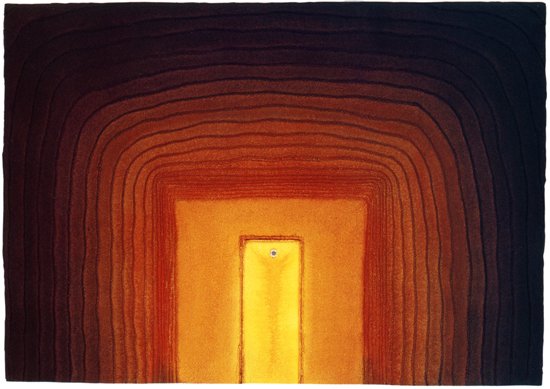
Sohan: There is something else I discover more and more these days. I never lack inspiration. There is always an empty canvas and there is always me in front of it waiting to be swallowed.
Bindu: Can it not provoke a crisis? It isn’t just fun, it is also a confrontation. Like when you meet a proper teacher.
I am a dot
in the full
emptying itself
in the void
filling itself
Sohan: I am waiting for that day where I don’t have to paint all these small pictures. Although it is not a desperate waiting, it is also fun and enriching, and I think that a harder discipline would make the road a little shorter, that is to use that experience I have from painting. Because I play the game of a ritual, then I can give and receive. And now I have that discipline, I have power as a supply. So little by little, there is less and less need of the ritual in itself.
Bindu: Life itself becomes a ritual.
I am a dot
in the sound unstruck
Sohan: Yes, the big canvas is more important than all the small ones, and then I do not have to paint any more.
Bindu: But you must do something.
I am a dot
in the animate
and in the inanimate
Sohan: Maybe one day a bigger picture has to be painted, I do not mean this in a literary sense. This picture, for instance, it returns some power to me, like it does to anyone who is open to it. Perhaps it is not the very same that I get. But it is an object, and something for the senses, even though I am not just senses. This picture can give me something and it can give you something. But the story does not end here, rather the story begins here.
I am a dot
in the maithuna
mudra and mandala
in the mantra
yantra and Tantra
Sex
Bindu: Tantra is also connected with sexual experiences.
Sohan: Yes, the way sex is linked with life, so it is also linked with Tantra. Sex has an important place in life and Tantra only gives it the position it deserves.
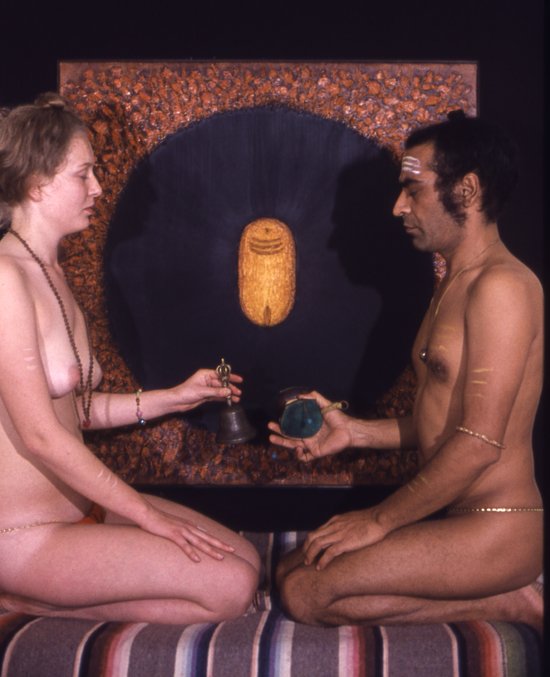
In other places, it has been pushed out from its central place by the aesthetics, by the religious aesthetics. It is a kind of aesthetics of Puritanism.
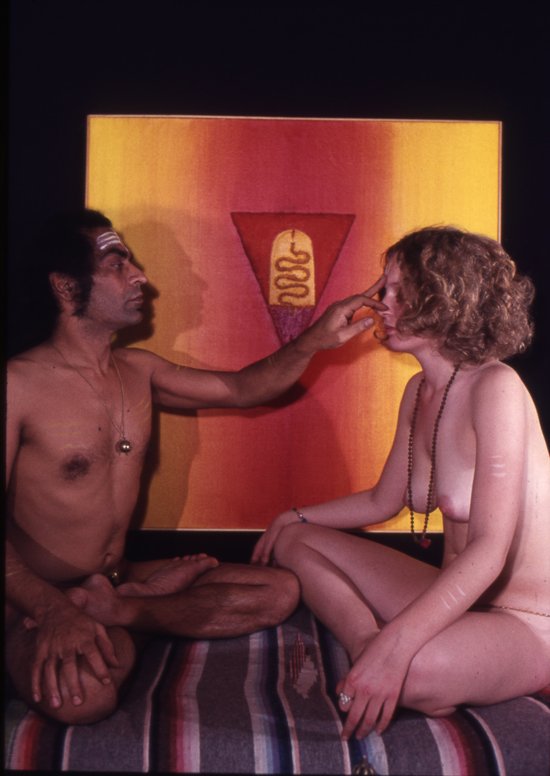
Just like in art, there was an aesthetics that had to be adopted to the habitual way of sensing and thinking, art for the sake of art, in the same way there was a religious aesthetics. In this religious aesthetics sex could not be a central part, the puritan attitude forbade it.
However, let us find another meaning in the word sexual — in Tantra. Quite simply, sex is a fundamental energy, psychically and physically both.
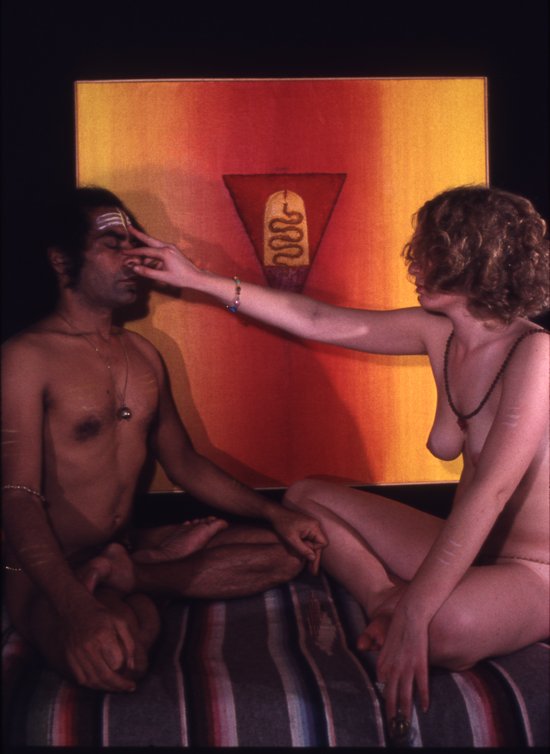
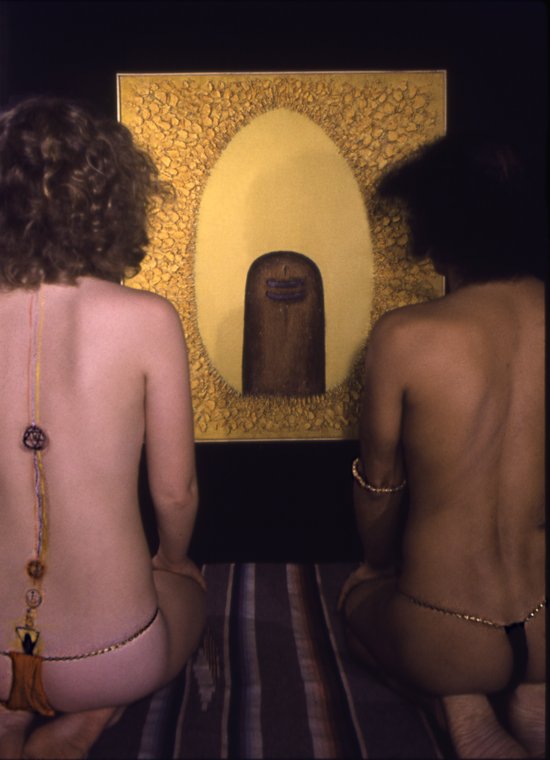
To me, the psychic and physical planes meet in sex. In every human being, the psychic and physical meet in the orgasm. And this meeting during the moment of ecstasy we call sexual. But the culture has enclosed this area with laws, wrong laws.
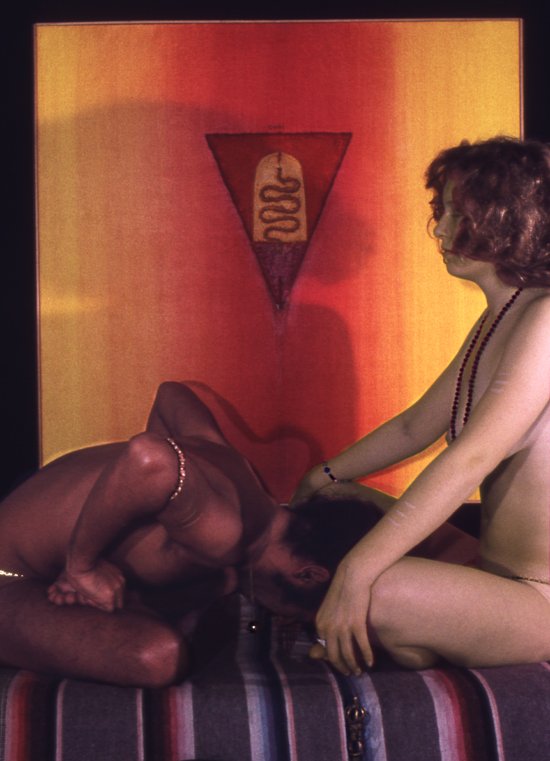
It reaches a peak and subsides again. But it has a peak, that is the beauty of it. On a very coarse plane, on the sthula-plane, the material and animal plane, the psychic and physical meet and reaches a peak.
Swami Janakananda: Yes, and the point about tantric meditation is that you must be able to start where you are — in your senses — when you sit down to meditate. This is not a scale of values; coarse is not lower than fine or subtle, it is the starting point each time, it is the first step on the ladder.
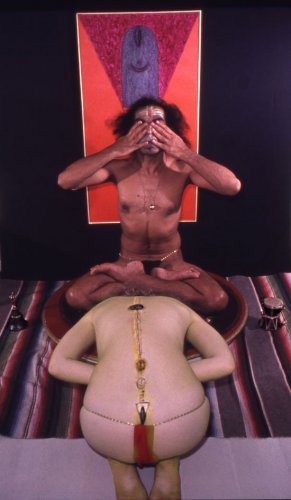
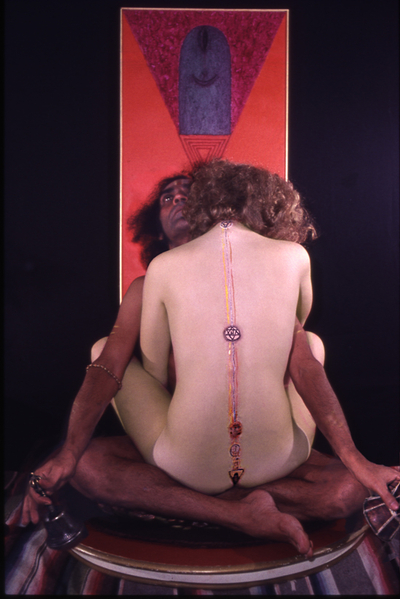
Sohan: Yes, and it happens in any case, there is ecstasy, and like everything is ritual, so also sex is a ritual. You must completely give in to the sexual situation, or there will be no sex. This is the same: if you don’t give yourself, you cannot paint a picture, you must let yourself be swallowed up fully, and you must let yourself be swallowed fully by sex, otherwise you cannot do anything with sex.
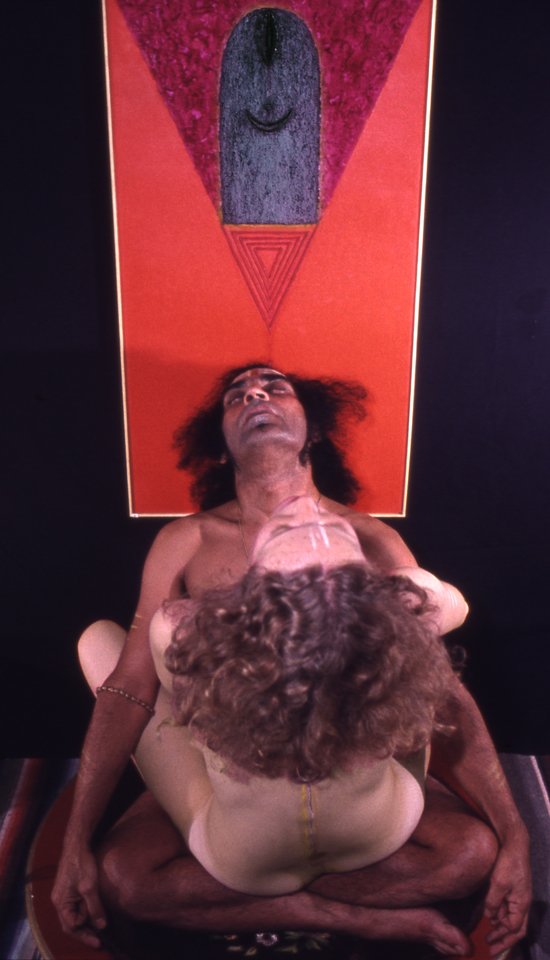
And it is this openness, that removes some obstacles and inhibitions. Because sex is so central, it is also stronger in removing these blocks — it happens halfway anyway, also for a normal loving couple.
I am a dot
in the orgastic ecstasy
so spiritual
and so mundane
at once
As I was mentioning, what we need when we have the ritual is discipline, to maintain it and to get the larger canvas, or a larger human being, a greater orgasm. Instead of all the technical nonsense about how you sublimate the semen by bringing it up to some other place. No, a greater being or a greater canvas.
But it does not mean that we are the only ones knowing this. People who do not know this do the same. The ecstasy is inborn, and the ecstasy is called ritual, and in that way, it can be called sex.
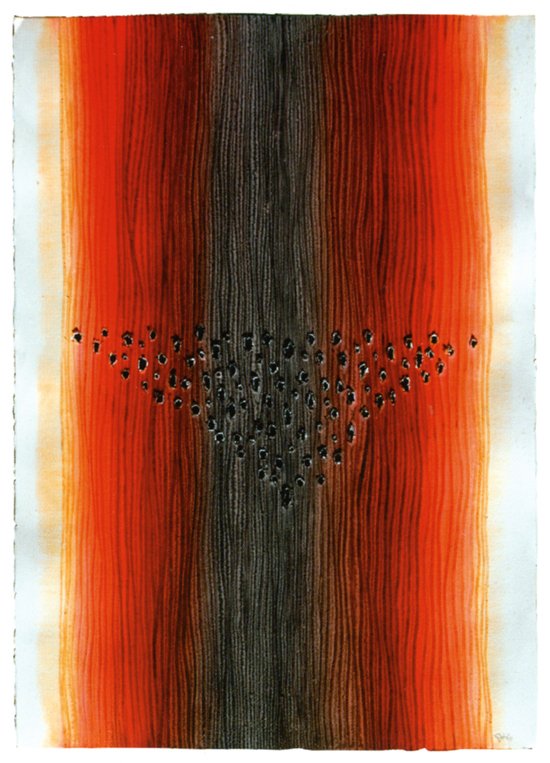
The Guru
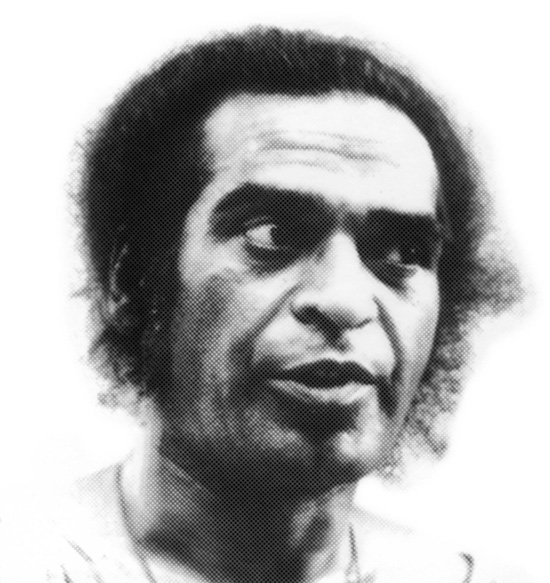
Bindu: Can you tell us about your personal experience of the relationship between teacher and pupil. Did you not have a guru?
Sohan: I have. If you have a guru, then you have it always, it is never ‘ have had’.
I am a dot
in the speck of dust
covering the cosmos
Bindu: Yes, in Arabia they say: if your love has gone, it was never there.
Sohan: It is a big question, and it is very personal. To me, the relationship has always been very naïve and it still is. He never told me anything, almost as if he would have said: “I will not tell you anything”.
So the doubts are there in the aspirant, they start to reel in the head by themselves, and they must be dissolved; if nothing happens, then it is not about being a pupil — if the doubts persist instead of letting them go.

My guru lived in a temple and people stayed around him if they wanted to; if they got tired of it, they could just leave. If they came to get intellectual knowledge, they were told that they could read a book.
I was nine years old, when I met him. So I was very young. I think that is why I still have this relationship to my guru.
I am a dot
in the becoming
and the being
When I was nineteen and attended university, now and again, I would go to see my guru, not because it was a condition. And I had my doubts, that happens to everyone, and I asked him: “Why can’t you tell me?”
“Well, you speak English? Why don’t you teach me English?” In that way, he rejected me. He did not know English, and I began to teach him English. Then it dawned upon me. Oh my god, he does not want to talk to me, then he gets me to talk.
Luckily, I had a teacher at an early age, my father and mother took me to the temple for an initiation in order to become a pupil of his.
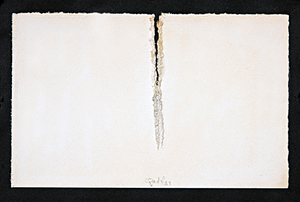
Bindu: What kind of man was your guru?
I am a dot
in the disillusioned
looking for illusions
Sohan: Originally, he was a singer and a dancer, a temple dancer. In India, all art was in the temple or in the palace; there was a deeply rooted culture in the temples, because people came there – to become cultivated.
Bindu: How did you meet him?
Sohan: The first time I saw him, he was performing rituals on the occasion of the renewal of the well in our farm. He was offering oblations to the gods and goddesses and chanting mantras to sanctify the ceremony.
He was a short structured man with clear eyes and a deep resonant voice. I was impressed by listening to his chant, and doing Yagya Agnihotra [a fire ceremony] near the well.
I am a dot
in the extraordinary
robed in the ordinary
Bindu: But you became his chela later on?
Sohan: I was initiated in his temple where he used to draw yantras to meditate on. One day I helped to draw yantras on the back wall of the temple. I remember how the walls of that temple used to vibrate with his voice. There was always a 'hum' around him.
He was popularly called Baba Brahmachari, but, paradoxically, a woman was living with him whom we used to call Mother (Mataji). As a tantric teacher, he was full of these paradoxical mysteries.
Bindu: But where did he come from?
Sohan: I was told he used to teach in Lahore [before the time when India was divided into modern day India and Pakistan]. From there, some of his students became very famous as dancers and musicians.
I am a dot
in the the dot —
free from dotiness
Bindu: But why would such a man renounce the world?
Sohan: One day, early in the morning, from our roof top I saw him chanting mantras and giving blessings to the householder living next door - and begging. I felt ashamed and almost hurt. I had high respect for Guruji, he was a great man in my eyes - and here, like a common beggar, he was asking for flour! I could not take it.
As a result, I decided to bring him a sack of flour. I took it on my bicycle and rode to the temple. Politely I offered it to Guruji saying "Please don't go begging, I can bring more for you". He looked deeply into me and said: "'Pugley' (little fool), do you think I beg for flour? It is part of my sadhana to curve my ego and lighten the karma ..." He gave the sack back to me smiling, "one day maybe you will understand".
Bindu: But would he otherwise preach that you should lower your ego and that sort of thing?
Sohan: No, not really. But when he renounced the world and took sannyasa, he began to beg. On another occasion, he said to me: "When you stretch your arm forward for alms - you cannot stay an egoist."
I am a dot
in the naked flesh
of the flame
burning eh! enlightening
Bindu: Let us return to the music, did he teach through music?
Sohan: He used to chant OM for three hours in the morning with his worn harmonium. Only two keys were working, the rest were unusable.
His temple was a one man temple, so he sat outside. No one knew him when he first came to the village. As he did not speak English, he was outside the culture. He came to the temple, which was situated halfway between our village and the next. People in our village thought the temple belonged to the neighbouring village and the others thought it belonged to us, so you can say it was placed in no-man's land.
He was a very simple person who danced all his life till he became around forty, then he withdrew and lived in this temple till he died.
Bindu: Withdrew? Did that mean that he got his food from people through begging only?
Sohan: Yes. People would give him some money or food and he did not need much. Students would come to him to learn to dance and they gave him some.
I am a dot
— the bindu
Perhaps he had been very egotistical as a dancer, maybe he had had a high opinion of himself. Even if he was a good dancer, it made his karma heavy and isolated. This, he could get rid of by begging. He begged by blessing people. And he did it by five doors and then began by the sixth the next day. When he became very old, however, he did not go out.
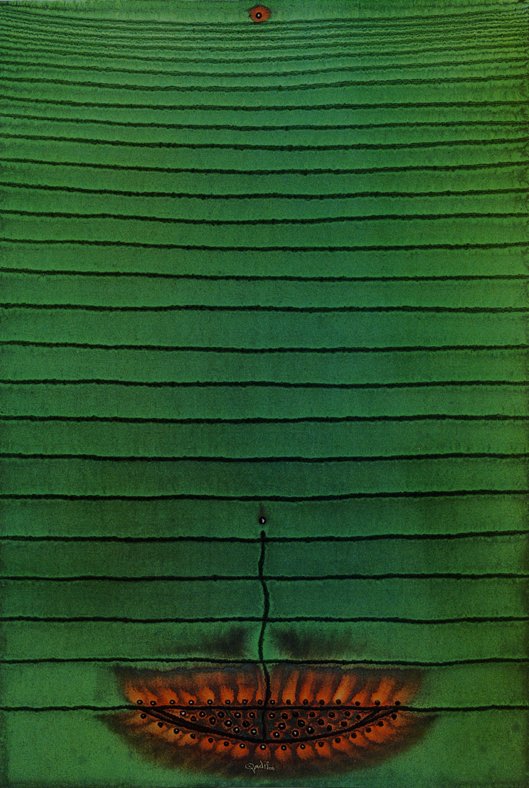
I am a dot
of the dot
in AUM
And people kept coming to him, they wanted to learn to play music, even if he did not want to teach. People came and settled down, he did not tell them to go away, he did not care and there were many.
Also read Yogini by Sohan Qadri — on the view of the woman, from the tantric tradition
____________
The 'dot' poems by Sohan Qadri was first published in the Danish issue of the magazine Bindu # 14, 1975 where the first edition of this interview was printed. The interview was revised and extended, with new illustrations in 2008. The poems later became part of a larger collection of his poems, Aphorisms, in 1988, containing the poems in both Danish and English. A new edition of these poems has now been published in English by Bindu Publishers in the book Wonderstand - Aphorisms and Poems (2009).
The paintings in this article are all by Sohan Qadri. The sexual ritual photos are by Torben Huss, Copenhagen. The photographic portraits of Sohan Qadri (1975) are by Swami Janakananda. On the last picture (below) you see Sohan Qadri and Swami Ma Sita in the desert outside Dubai, photographed by Swami Janakananda.
Today, Sohan Qadri is a well known artist, and is shown, for instance, in the galleries: Sundaram Tagore Galleries in New York, Beverly Hills, Singapore and Hong Kong, and Kumar Gallery in New Delhi.
This interview has been published on this web site 2008, with the co-operation and consent of Sohan Qadri. All rights reserved © 1975 and 2008 Bindu Publishers, Scandinavian Yoga and Meditation School and Sohan Qadri.
